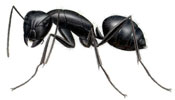Ants are ubiquitous outdoors and many species invade homes regularly where they may feed on human food sources and/or establish indoor nesting sites. Most ant species dwell solely in the natural environment and are not considered pests, but a minority of ant species have adapted to living in manmade environments, such as neighborhoods and urban areas. All ant species that are categorized as pests have adapted to exploit human environments to some extent, but some ant species are more at home among humans than others. Generally, the most troublesome ant pests are the ones that are best adapted to thriving in human environments. Odorous house ants would definitely be one of these ant pests due to their ability to establish nests within just about any human environment, including homes, potted plants, under doormats and even in cars. Odorous house ants are commonly found in abundance around the foundations of homes, particularly in garden mulch, shrubs and flower beds.
Unlike many ant pests in the US, odorous house ants are native to North America, and they dwell naturally within wooded environments, which makes them particularly abundant in Massachusetts where wooded areas account for 60 percent of the state’s land. In their natural wooded habitat, odorous house ants are considered beneficial insects due to their habit of breaking down dead plant matter, but in urban and suburban environments, odorous house ant populations explode to the point where colonies can span entire city blocks. Odorous house ant populations are held in check by a variety of predators in wooded areas, but in human environments, these ants have much more freedom to establish nesting sites wherever they like. Since odorous house ants break down dead wood and other plant materials in their natural habitat, they naturally congregate in mulch and dead plant matter surrounding homes. Once odorous house ants become prevalent around the foundation of a home, it is only a short matter of time before the ant pests find a way indoors. Odorous house ants are small and can easily squeeze through tiny cracks in a home’s foundation, so sealing all foundation cracks and making sure windows are properly screened will help to keep these ants outdoors where they belong.
Have you ever smelled an ant for the purpose of identifying the species?

